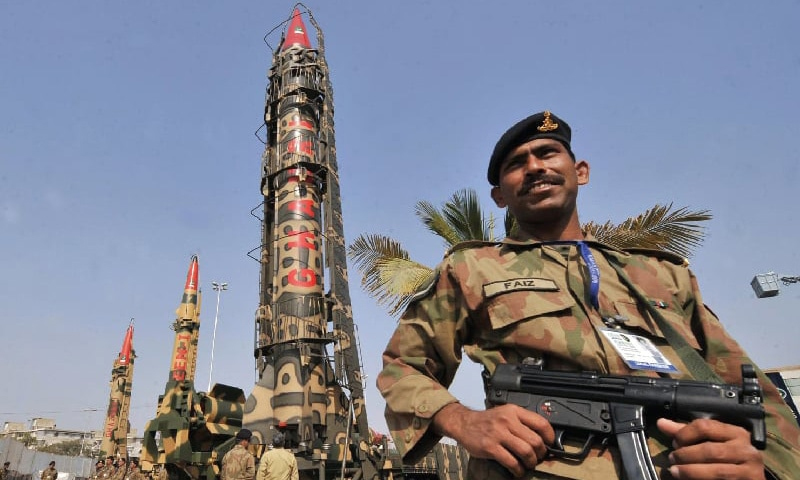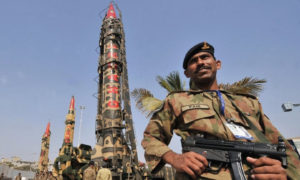Induction of MIRVs in South Asian Region
Photo credit: Herald, Pakistan
Usman Ali Khan
Successful test-firing of indigenously-developed submarine launched cruise missile Babur-3 by Pakistan is the sign of an imminent stabilizer in the region. Keeping itself on the heels, the surface-to-surface ballistic missile test of Ababeel comes as an efficacious attainment of second strike capability, covering a major scientific Multiple Independent Re-entry Vehicle (MIRV) technology milestones.
Not surprisingly, an addition of the aforementioned missile in covering a strategic milestone with the incorporation of MIRVs technology has drawn extensive debates from scholars and academics voicing their concerns. Apart from all the debates, India has also conducted a number of missile tests, for example, Agni-I, Agni-II, and Agni-III, to counter Pakistani threat specifically, plus Agni-IV and Agni-V that can carry MIRVs payload to threaten the Chinese counterparts.
Pakistan is not the only one that veiled this technology of MIRVs in South Asia. The regional drivers to investigate the strategic motives of Pakistan’s addition of such missile’s need a balanced assessment. Indian dual pursuit of both BMD and MIRVs is the basic driver that led to a more intensified strategic competition between India and Pakistan.
The armament dynamics are far more complex when it comes to the missile development being done by India as concluded by Joshua T. White and Kyle Deming in their chapter titled, “Dependent Trajectories: India’s MIRV Program and Deterrence Stability In South Asia.” This apparently rapid pace of nuclear developments in India has made it possible to accelerate the current arms race between the two countries. Which includes the development of BMDs, to the Technological advancements regarding combat aircraft; nuclearisation of Indian Ocean; air defense capabilities; cruise and ballistic missiles; sea-based deterrents; ballistic missile defense (BMD); and multiple independently targetable re-entry vehicles (MIRVs).
The missile development trajectory, if viewed from the right lens depicts a different story. It is within this context that in June 2016 India formally joined Missile Technology Control Regime (MTCR) after years of negotiation. But soon after this, India and Russia joined hands to develop BrahMos cruise missile with a range of 600km that can hit entire Pakistan. This clearly shows the so-called commitments India has to any non-proliferation objectives it signed.
Ironically, it is pertinent to note that though India adheres to MTCR ground facts show a different perspective, where India appeared divergent in stopping the spread of nuclear technology by developing missiles through vertical proliferation. Two important question that may arise in one’s mind are:
What were the diplomatic procedures through which India got this 35-nation MTCR membership, where it can indulge in exporting missile and technology to African, Gulf and Southeast Asian states and violating MTCR guidelines?
After becoming a member of MTCR, India has violated the guidelines by conducting a missile test with a range of 600km. How can a state that is seen violating the treaty as a member still be counted as a guaranteed member?
After the successful launch of Agni-V with a range of 5000km, India is in pursuit of improving this MIRV to more extent in the name of Agni-VI. It is believed that the missile will have the capacity to drop multiple independently targetable re-entry vehicles (MIRV) with a more calculated range. Therefore, such additions for their aspirations will have the potential to lead a nuclear war and deteriorate the global security environment as well.
Not only this, nuclearisation of Indian Ocean by India is another milestone that is making impulse in the already existing fragility of the situation in the region. India proceeded with MIRVs way back in 2013 when it first conducted an undersea missile test, hence, completing its nuclear triad. The Defence Research and Development Organisation (DRDO) again flight-tested its K-4 missile with a range of 3000km in 2014.
Keeping in mind all the developments taken by India and the extent of negative ramifications they have for the Asian region, no one dares to show any concern about this affecting the strategic stability of the region as India enjoys a head start over Pakistan. Nevertheless, a retired Rear Admiral Raja Menon and a strategic analyst showed concern that “India intends to deter nuclear use by Pakistan, while, Pakistan’s nuclear weapons are meant to compensate for conventional arms asymmetry.”
While India has been operationalizing its respective deterrent and is building triads, Pakistan cannot let go of its security concerns and has to match the regional military developments which are essential for its survival. Looking back at historical developments, Pakistan has developed its arsenal at a measured pace. Therefore, euphemistically, there must be a greater international acceptability for Pakistan as it is acting as a deterrence stabilizer in the region.


